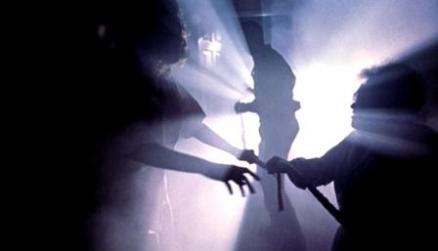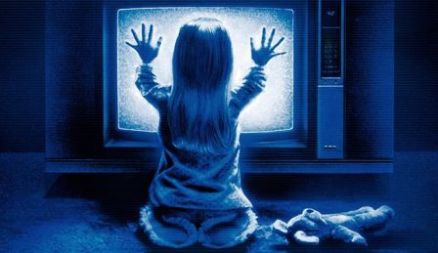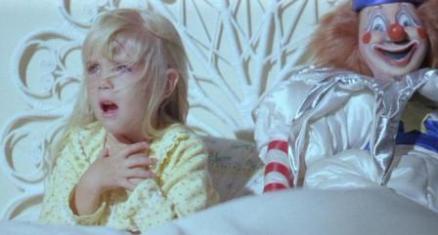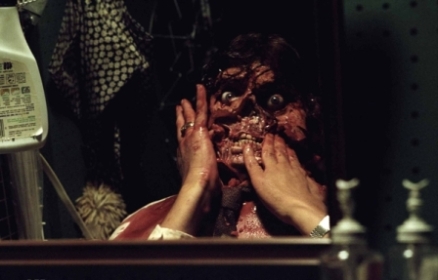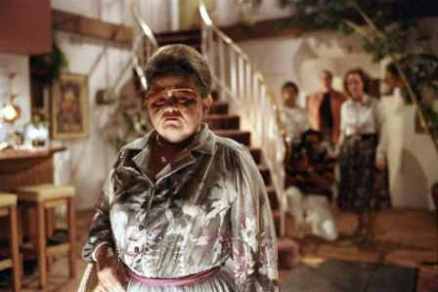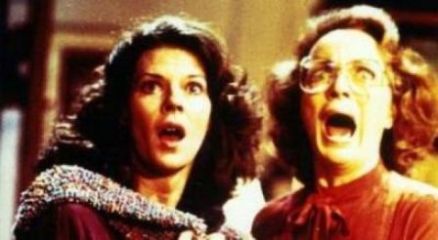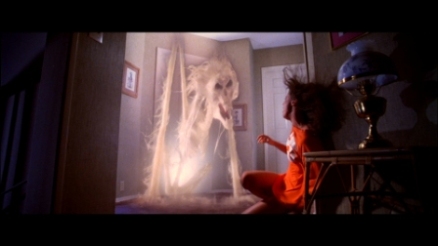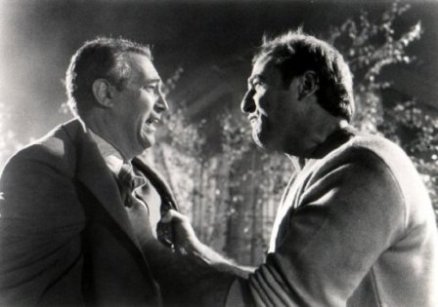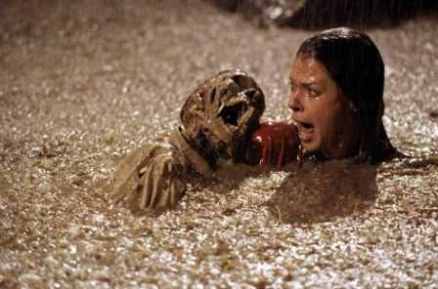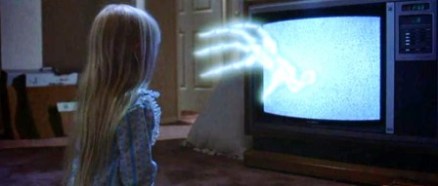Poltergeist
(1982, dir. Tobe Hooper)
by Andres Baca
FILM DATA: TRAILER: http://youtu.be/5ytjaMfoF2M
Poltergeist was directed by Tobe Hooper, written by Steven Spielberg, Michael Grais, and Mark Victor from a story by Steven Spielberg. It was released on June 4th, 1982. No information is available on the movie’s budget but it made $76 million domestically. Also, no figure is available on foreign box office. The film’s music was composed by Jerry Goldsmith. It stars Craig T. Nelson (as Dad/Steve Freeling), JoBeth Williams (as Mom/Diane Freeling), Beatrice Straight (as Dr. Lesh), Dominique Dunne (as Dana Freeling), Oliver Robins (as Robbie Freeling), Heather O’Rourke (as Carol Anne Freeling), and Zelda Rubinstein (as Tangina). This was the first movie in Steven Spielberg’s stratospherically successful 30+ year career as a producer and as of the date of this posting the worldwide take of the all movies Spielberg has produced (not necessarily directed) is $13.35 BILLION (according to Box Office Mojo)!!!!!
SYNOPSIS:
As the movie opens the Freeling family is living in a relatively new suburban neighborhood. Steve Freeling (Craig T. Nelson) is a top real estate agent who is responsible for the home sales of nearly half of the city.
Steve has a bad habit of leaving the TV on while he’s sleeping. When the day’s broadcast ends, the television turns to static and a mysterious transmission comes from the television set.
At first only the 6 year old Carol Anne (Heather O’Rourke) notices and is drawn by this. She tells her parents but they shrug her away.
The following nights Steve leaves the TV on, little does he know that it is a portal into another dimension! Supernatural forces invade the house through the television.
The next day, the house finally infested by these otherworldly beings, the haunting begins innocently at first: chairs move by themselves, objects restack themselves in odd ways, et cetera.
At first the Freeling family does not see this as a threat. They ask their neighbors if they’ve experienced something similar but they haven’t. This paranormal phenomenon seems to be concentrated at the Freeling household.
A few nights later, while 11 year old Robbie Freeling is sleeping he is attacked by a tree outside his window!
The tree tries to pull Robbie into itself, but his father rescues him from it.
Little do they know that Carol Anne is sitting in front of the television speaking to the beings on the other side. Suddenly the door to the closet opens, and a bright light shines out of it, the light sucks everything from the room into itself, and finally it sucks in Carol Anne.
Steve Freeling takes his case to paranormal investigators who come to his house. One of these investigators is scared away after he sees a slab of meat crawling over a counter and has an overpowering hallucination of his face melting off his head.
The investigators tell the Freelings that their daughter Carol Anne is in another dimension but is still alive. And the head investigator says that she is going to bring in the big gun: a diminutive paranormal specialist called Tangina (Zelda Rubinstein).
Tangina can hear these otherworldly forces, but although she can see and hear the beings in the other dimension she cannot speak to Carol Anne. Carol Anne, Tangina says, will only listen to her mother.
So Mrs. Freeling, with the help of Tangina and Mr. Freeling, travels to the otherworldly dimension in which Carol Anne is being held captive, not by force, we learn, but by deception. By a being who is a “beast” but has taken the form of a child.
Tangina throws a tennis ball through the entrance and it comes out through a portal in another part of the house.
Mr. Freeling holds a rope from the entrance to the portal and one of the paranormal investigators holds a rope from the exit with Mrs. Freeling tied in the middle.
In doing this they rescue Carol Anne. And for a moment everything appears to be over.
Steve tells his boss Mr. Teague (James Karen) that he is planning on moving, but Mr. Teague reveals that he plans to build a whole new house for the Freelings, and a whole new housing development…on top of a cemetery!!!!!
When Freeling protests, Mr. Teague responds that it’s no big deal, that he will, as he has done before, merely move the grave area to an area just outside the city so that concerned relatives will still be able to visit at a location not far from the original cemetery.
The next night the poltergeists attack again. The beings try to suck Carol Anne back through the portal and make Robbie’s own toy clown attack him, while skeletons try to drown Mrs. Freeling in the family pool.
Coffins burst out of the ground all over the house and its grounds.
Mr. Freeling arrives home with his boss and grabs him violently upon seeing what is happening “You moved the headstones… but you left the bodies!!!!!!!”
Graves start bursting all over the city.
The Poltergeists were deceased people who were angry that homes were built over their burial grounds.
Mrs. Freeling rescues her children and the dog and herds them all into the car, which Mr. Freeling races away from town.
In the final shot the Freelings enter a motel room. There is a pause as we hear something being dislocated inside the room.
Mr. Freeling yanks the television set and throws it outside.
COMMENT:
Poltergeist begins with an extreme close-up of what appears to be a screen of some sorts. We see bits and pieces of it but not the whole thing. An instrumental version of the “Star Spangled Banner” plays in the background powerfully and patriotically. This is a very unusual piece of music to start a horror film to. It sets us off balance.
The camera slowly moves back to reveal corresponding patriotic images on a normal television screen: of the flag, of the monument of the marines raising up the flag at Iwo Jima, et cetera, suddenly the screen turns to static. Ominously the static lingers for longer than is normal…
A man (who will be revealed to be the Freeling family patriarch) is lying asleep on his couch.
Only the dog is awake.
As the dog travels to every room of the house, Tobe Hooper introduces all of the main characters of Poltergeist at the moment when they are most vulnerable: when they are all asleep. Meanwhile the TV which remains on a screen full of static, and is the only light source in the room, gives off a very creepy vibe. And instead of assuming a defensive or combative posture, the dog travels to each one of the Freeling family’s bedrooms, not to check to see if they are safe, but to check if any of them have left any food lying around (there is some humor as the dog pulls out a bag of potato chips from under Dana Freeling’s pillow and leaves a trail of crumbs in his wake). This is a cute scene, but it also serves to show the audience that this family will be quite vulnerable particularly after having expectations set by the movie’s publicity that the terror will come from a television screen (the film’s advertising featured a little girl sitting in front of a television screen in the darkness, the only light coming from said screen).
In this film Tobe Hooper uses as a source of terror, not darkness but bright and overpowering light. It is a low budget effect to be sure, but a beautifully haunting one.
That the only one of the characters who is sensitive to the disturbance emanating from the television is the six year old Carol Anne Freeling, is not only a sign that there will be trouble, but a parallel with other Spielberg produced and/or directed movies like Hook, E.T., The Goonies and even the recent Super 8, in which the littlest kids are among the first in their respective movies to witness or discover the wonders/horrors which are at the center of their respective films.
That Mr. Freeling’s first name is Steven tightly ties Spielberg (who as I said above not only produced and wrote the movie, but also came up with its story) into the movie powerfully as one of its characters. In a similar way, his best friend George Lucas did the same thing in Star Wars, tying himself to his movie’s main character by giving him a similar name to himself (“Luke” sounds and looks similar to “Lucas”).
In Spielberg’s 80’s films, action figures and merchandise from his best friend George Lucas’ blockbuster space saga also populates the mise en scene. For example, in Poltergeist in one scene Carol Anne chews a Luke Skywalker action figure like a cigar and Robbie Freeling’s bed-sheets are Star Wars bed-sheets, he even has a bust of Darth Vader behind his bed! If you’ll remember in E.T. Spielberg not only had a scene with Elliot playing with Greedo, a Star Wars action figure, but he also had E.T. himself run into a little kid dressed up like Yoda for Halloween!
In Poltergeist you also have the suburban landscape which is a major part of the setting for many Spielberg films (for example Super 8 and E.T.). In E.T. Spielberg uses the backdrop for an epic action sequence: the scene where Elliot, on his bicycle, is chased through the suburban type landscape by police in cars.
this shot from Poltergeist is similar to a shot in Spielberg’s Raiders of the Lost Ark in which Karen Allen is also accosted by skeletons. One of many traits Poltergeist shares with other Spielberg directed and/or produced films.
Between E.T. and Poltergeist and other Spielberg films you also have the issue of corrupt and mislead authority. Adults who are unable to wonder and who have their hearts hardened by age, responsibility and rationality, like Peter Banning/Peter Pan (Robin Williams) from Spielberg’s Hook. Like in Close Encounters of the Third Kind, within which the wonders of the aliens are increasingly revealed to Roy Neary (Richard Dreyfuss) as he grows more and more child-like. In E.T., another example, the adult authorities wishing to do research on and dissect E.T. as if he were just a frog, another animal to be studied, and by doing this the adults unwittingly cause E.T. to wither away in the process.
In Poltergeist you have the “adult villain” in the form of the housing developer Mr. Teague who in the name of profit and practicality profanes the sacred by building his entire housing development over a cemetery and reaps the consequences. Similar to the Nazis in Spielberg’s Raiders of the Lost Ark who reap the consequences of trying to open the sacred dwelling place of the Judeo-Christian God; or the Nazis in Indiana Jones and the Last Crusade who try to remove the sacred cup of Christ to put it in profane (the Nazis) hands, but end up reaping their own destruction as a result.
Another theme of Poltergeist is obsession with television. Our never wanting to turn it off, the fact that in the 80’s and today there is a television for practically every room of the house. A theme that still plagues are culture but has mutated to several new forms with the advancement of technology. An obsession with having our eyes transfixed by screens: not only television screens, but personal computer screens, tablet screens, telephone screens… and even the screen you are reading this blog on right now!!!!
Poltergeist, released in 1982, resonated with a television obsessed culture, this is a large reason for its box office success. A remake of Poltergeist today in 2013, and it should be made I think, could exploit our ubiquitous, omnipresent and prolific use of screens in an even more terrifying way than ever before, because now they exist wherever we turn! More portals through which evil can emerge and more opportunities to terrify audiences = potentially huge box office.
